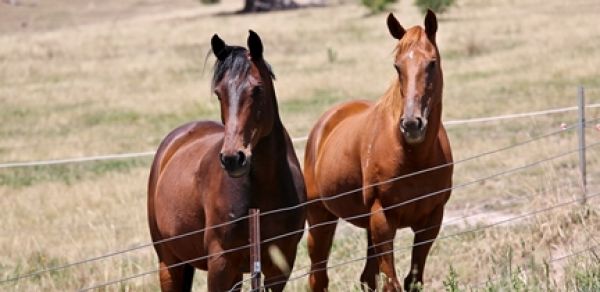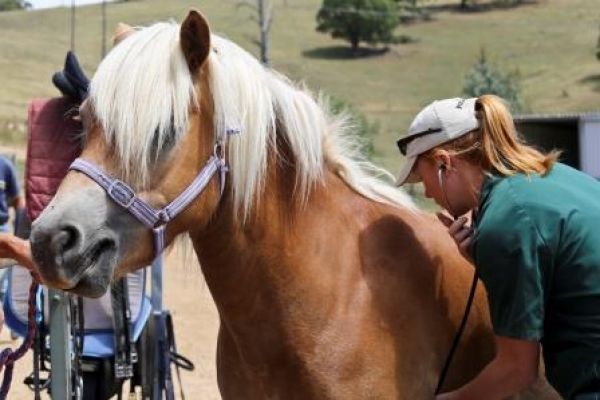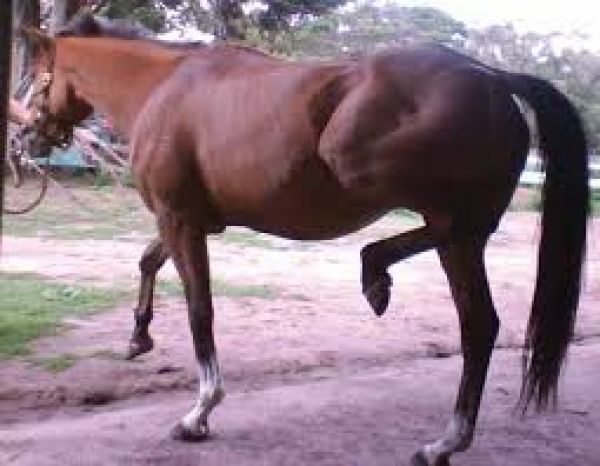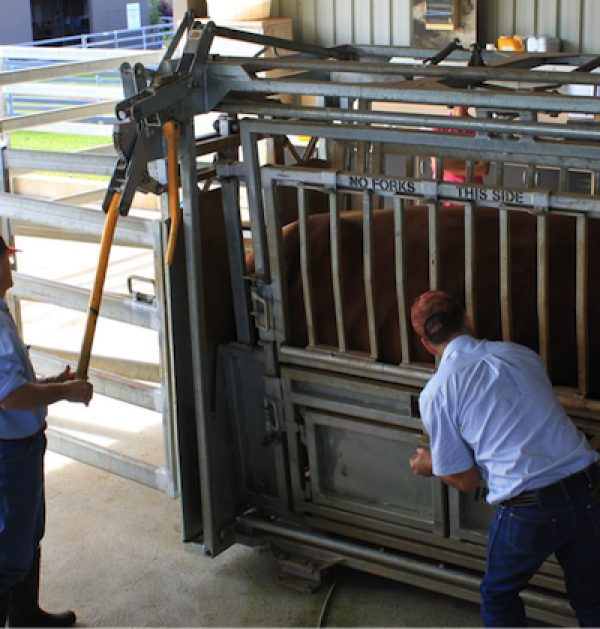 |
|

|
 |
 |
March Large Animal News |
March 2016 |
 |
|
 |
Australian Stringhalt
Recently our vets have seen a number of cases of stringhalt - vet Kate explains the symptoms and causes of Australian Stringhalt and what to look out for.
"During hot dry conditions we tend to see a few horses with stringhalt. Horses with Australian Stringhalt often present with exaggerated flexion of one or both hind legs. They step very high and may be uncoordinated. Clinical signs may be worse when a horse is stressed, backing up or excited.
The neurotoxin is believed to be produced by plants such as flatweed and dandelion. When the plant is stressed (during dry conditions or after spraying) higher levels of toxin are found in the plant.
The clinical signs of stringhalt are dependent on how much of the plant has been ingested. Horses are selective eaters and only one horse may be affected in a paddock of several horses. Typically thinner horses and Clydesdales are more susceptible than fat horses and ponies.
Treatment requires waiting for the nerves to recover. Horses must be moved from their current location to a new paddock or off pasture completely. Horses may be affected for 2-18months. Please contact your vet for treatment options for each individual horse."
Prevention is crucial to maintaining your horse’s health and mobility. Make sure you check your paddocks regularly for weeds, especially when feed levels get low or pasture dries off.
|
 |
  A picture typical of affected horse
image courtesy rirdc.infoservices.com.au
|
 |
 |
|
|
|
|
|
 |
 |
02 No foot, no horse - and no cure |
 |
 |
|
 |
Laminitis is one of the most devastating equine diseases. Advanced laminitis causes severe chronic pain, eventually leaving sufferers unable to stand at all.
Laminitis is inflammation of the lamina, which is the connective tissue between the bone and inside of the hoof wall. It is a complicated disease where often several factors contribute to the onset of the condition.
Inciting factors may include:
- Underlying equine metabolic syndrome or Cushing's disease
- Gorging on carbohydrate dense feeds
- Severe systemic infections
- Abnormal biomechanical forces on the hoof
Prolonged and severe inflammation of the lamina can cause the hoof wall to lose its attachment to the underlying bone. As the horse bears weight down through the leg the bone can rotate away from the hoof, and sink closer to ground. In severe cases the bone can protrude throught the sole of the foot.
Ponies and miniature horses, broodmares and overweight animals are at increased risk of laminitis. Recognising the signs of the disease early is critical. Signs of laminitis include:
- lameness and reluctance to move
- bounding digital pulses and hot hooves
- lying down excessively
- ‘rocking horse’ stance
- concentric hoof rings
Managing a laminitic or at-risk animal requires dietary management (feeding a low sugar diet and restricting overall feed intake), remedial shoeing or trimming, and anti-inflammatory medication as required.
Hoof x-rays confirm the position of the bone within the hoof which is useful for assessing severity and planning trimming or shoeing. Remember once the lamina has separated it can never be re-attached. Some horses and ponies can continue competing successfully with good management, but unfortunately the quality of life for some is irreversibly impacted.
Call us to discuss managing your horse or pony's feet. Remember in this case, prevention is the only cure!
|
 |
 |
|
 |
 |
03 Cattle crush design and safety |
 |
 |
 A good cattle crush is both safe and efficient to use
|
|
 |
A well-designed crush makes for efficient, low stress and safe cattle handling. As vets, we have seen the full spectrum, from hydraulically operated walk-through crushes to the older style guillotine crush. From our perspective we are looking for a crush which is efficient to work in and safe. The cattle crush can be a dangerous place – injuries from crushing, being kicked, or being knocked by fast moving parts of the crush have been all too common.
Choosing a crush will depend on a number of factors including stock to be restrained, the procedures to be performed, staffing levels and experience, and cost. There will not be one crush which suits every purpose.
To help vets, farmers and manufacturers with design and selection of appropriate crushes, the Australian Cattle Veterinarians have put together a document which is now sitting on their new website. Head to mycattlevet.com.au/cattle-crushes if you are thinking about investing in a new crush, or download the mini-publication.
|
 |
 |
|
 |
 |
04 Equine metabolic syndrome: be cruel to be kind |
 |
 |
|
 |
Equine metabolic syndrome (EMS) is a very common disease of equine animals, especially ponies. It can have dire consequences if not properly managed including chronic obesity and laminitis. Obese ponies are at severe risk of hyperlipaemia or ‘fatty blood’ which can cause death.
Ponies and small horses evolved to survive in very harsh conditions where rich feed was sparsely available. To survive they became small, needing less feed, and their endocrine (hormone) system developed an inability to adequately process sugar-rich diets. Nowadays ponies are kept domesticated, often where ample feed is available - which has led to the emergence of EMS.
Ponies, not used to such a rich diet, are prone to persistently high levels high levels of insulin in their blood. Insulin is the hormone responsible for lowering blood glucose to the normal level, and ponies can become resistant to the effects of their own insulin. Similar in some ways to type 2 diabetes in humans, insulin resistance causes fat to be laid down excessively and harms the health of the lamina in the hoof.
Signs of EMS include:
- easy weight gain
- cresty neck
- abnormal fatty deposits
- chronic laminitis
EMS is often suspected based on these symptoms, but the diagnosis can be confirmed by blood tests. The condition can be successfully managed by controlling a pony's diet and encouraging exercise. At risk or affected ponies must be fed a diet low in simple carbohydrates including grain, concentrate feeds and often access to pasture must be restricted. This is what is termed a low GI (glycaemic index) diet. Medications can be prescribed to aid management in severe cases, and any signs of laminitis should also be addressed.
Call us today to chat with our experienced veterinarians about how to best manage the health of your pony or horse.
|
 |
 |
|
 |
 |
05 Understanding the Australian Animal Welfare Standards |
 |
 |
|
 |
Animal Health Australia has announced the Australian Animal Welfare Standards and Guidelines for sheep and cattle, that have been agreed upon by State and Territory governments. These guidelines will be used by states and territories as a basis for relevant animal welfare law.
These guidelines are important for you to understand as a livestock producer. They cover off on:
-
Basic requirements such as feed and water
-
Risk management of extreme weather, natural disasters, disease, injury and predation
- Facilities and equipment
- Handling and husbandry
-
Tail docking and castration – age limits, tail stump length, pain relief
-
Mulesing – age limits, pain relief, breeding management, procedure guidelines
-
Breeding management – managing ewes and lambing, newborn lambs, rams and artificial breeding technologies
-
Intensive sheep production systems – feed and water, management, inspections, sheep behavior, disease prevention, pen density, facilities and environment, contingency arrangements
-
Humane killing – when it’s appropriate, how it should be done and your responsibilities
-
Castration, dehorning and spaying – appropriate age for the procedures, pain relief requirements
-
Calf rearing systems – colostrum and feeding requirements, stocking density, bobby calves
-
Dairy management – shed maintenance, heat stress mitigation, animal health, tail docking, feed pad maintenance
-
Beef feedlots – stocking density, diet management, heat stress mitigation, animal health, accreditations
If you have questions about any animal health treatments, disease prevention programs, pain relief options etc., we are happy for you to call us.
|
 |
 |
|
 |
 |
06 Ovine brucellosis: more common than you may believe! |
 |
 |
|
 |
There is a common perception among producers that ovine brucellosis (OB) is an issue of the past. If you hold this view, unfortunately you are misinformed. A recent survey of OB in the Riverina by Senior District Veterinarian Dan Salmon found 31% of flocks (109 of 353) were positive for the disease.
OB is a bacterial disease acquired by rams. Infected rams are either subfertile or infertile, which causes moderate to severe reductions in the pregnancy rates of ewes. A recently infected mob will often exhibit a 30% reduction in pregnancy/lambing rate - this alone is an enormous cost to the business, before considering the loss of infected rams needing replacement. On the other hand, once OB is eradicated from a flock, it's common for ram percentages to reduce by up to 30%, joining periods to reduce by up to 50% and lamb marking percentages to increase by 30%. Clearly this is a disease worth managing out of your sheep flock.
To get an idea of the chance of OB in your flock, you need to get an idea of the ewes' fertility profile. This starts with pregnancy scanning, followed by lambing percentages, marking percentages and weaning percentages. If there are significant variations in these numbers, or your scanning performance is sub-par, this should be investigated.
There is no treatment for rams already affected with the disease, therefore it is prudent to:
- Have sound farm biosecurity – good fencing, ram paddocks etc.
-
Communicate with neighbours regarding stray rams
- Only source rams from accredited OB flocks
- Don’t buy rams from saleyards or dispersal sales unless you have checked the relevant status and done your own risk assessment
-
Know your own flock – learn to palpate your own rams or get a qualified vet to help
As always, if you've any concerns about the health of your flock, please call us.
|
 |
 |
|
|
|
|
